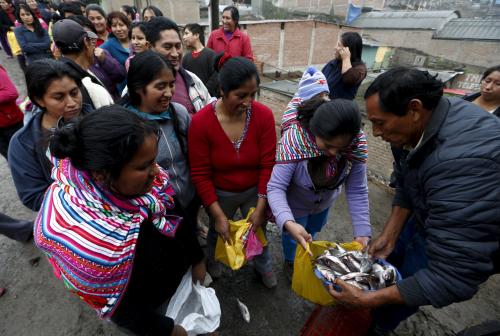Lower-middle-income countries spend 1.4 percent of GDP on social assistance that reduces relative poverty by 7 percent. Yet, only 54 percent of the poorest quintile are covered by the transfers. Several reasons could explain this shortfall: insufficient budget, different objectives from poverty reduction for social assistance, concerns over work incentives, and inability to target and deliver assistance. However, an important but underappreciated reason is the fear of a bureaucrat being accused of fraud. The attendant bureaucratic behavior focuses the administrative effort on avoiding errors of inclusion while tolerating high rates of exclusion errors. Many welfare programs rely on targeted assistance to reduce poverty. The degree of success of such programs depends on the size of inclusion and exclusion errors. Inclusion errors occur when nonpoor households receive transfer payments. Exclusion errors occur when poor households receive no payments.
Why is there so much administrative effort focusing on eliminating errors of inclusion? Perceptions of high inclusion errors can erode trust in a social program. A few high-visibility cases of “undeserved” payments can raise suspicions of preferential treatment and corruption and cast doubt on a program’s transparency and sustainability. The myth of the welfare queen is a potent stereotype used by politicians in the U.S. to argue for cuts in social assistance; it sends a signal to officials that leakages need to be curtailed even at the expense of an inclusive safety net. In countries where even suspicion of corruption could lead to severe punishment, government officials try to minimize errors of inclusion at great exclusionary cost. Such efforts can lead to stigma for beneficiaries, high claiming costs using burdensome administrative requirements, lack of outreach, and administrative rationing based on overly restrictive eligibility criteria. Publicizing the names of program beneficiaries, as China has done, may facilitate community control over “undeserving” recipients, but it can also discourage households in need who are ashamed of their financial status from applying for benefits.
However, inclusion and exclusion errors have a different long-term impact on households, society, and the economy. The welfare impacts of exclusion errors may be far more severe and fiscally costlier over the longer term than those caused by inclusion errors. An extensive body of literature on the impact of poverty spells and poverty traps shows that even a short period in poverty can lead to long-lasting economic and social consequences. The impact can be especially harsh for households with children. Poverty episodes experienced early in life can result in chronic health conditions, juvenile delinquency, unemployment, and potentially criminal behavior later in life. The burden on the country’s future social safety nets and other social spending such as health could be large. For example, the 10,000 highest-cost clients of the social services system of New Zealand are each expected to generate lifetime budgetary costs of $500,000 or more, involving a total cost of $6.5 billion.
The focus on reducing errors of inclusion is entirely rational from the bureaucratic perspective. A bureaucrat whose actions result in payments going to the nonpoor might be accused of corruption, investigated, and even prosecuted. But much of the social costs of not helping the poor will be realized in several years or even decades after the program implementation. By that time, the bureaucrat might not be working on the program (or working at all). Having programs evaluated externally could help reduce this problem. But if independent evaluations are costly and the attribution of success difficult, agencies are likely to prefer clearly defined categorical targeting (such as those based on family composition, disability, unemployment, or age), in order to safeguard themselves against the risks of program failure. However, categorical schemes are notoriously inefficient at reducing poverty and may exclude many of the poor.
In most countries, the implementing agency is responsible for establishing eligibility criteria, identifying program beneficiaries, as well as distributing assistance. But the agency’s performance indicators cannot be clearly attributed to the agency’s efforts. One approach to reducing such “agency” costs is to reduce (a) the asymmetry of information between society (represented by elected government) and the agency and (b) the risks carried by the agency. Representative household surveys could be used to monitor the agency’s targeting performance. Random checks of program beneficiaries would show how well assistance was distributed. Such imperfect and costly monitoring can help reduce but not eliminate information asymmetry. The agency can still tailor its performance to achieve its internal goals rather than societal goals.
A more powerful idea is the delegation of the identification of beneficiaries to a different entity; having a central ministry play the policymaking, coordinating, and monitoring role would reduce the risk to the identifying agency. It would help define clear, measurable objectives for both organizations, creating a better incentive structure for bureaucrats and reducing opportunities for corruption. Under this trias politica (separation of powers), the central government would determine the tolerance (from the societal point of view) for errors of inclusion and exclusion and communicate these objectives to the identifying agency. Not being involved in monetary transactions, the identifying agency would have fewer incentives to misclassify beneficiaries. Its performance could be verified through periodic representative household surveys. The agency would be evaluated based on the incidence and profile of program beneficiaries compared with statistics derived from independent surveys.
An important example of an identifying agency tasked with screening—through outreach, intake, registration, and eligibility determination—is the social registry. The social registry agency could play a more independent role in ensuring the inclusion of eligible populations. It could also exploit economies of scale by designing an information system for all programs that depend on means-testing for eligibility. Brazil’s Cadastro Unico—which ensures that anyone can register and apply for many benefits and services at any time—is an example.
The “distributing” agency would focus solely on distributing assistance to the beneficiaries identified by another agency. Random checks of beneficiaries could easily measure the agency’s performance. Such a separation of responsibilities might help reduce the bias towards avoiding errors of inclusion. For example, Australia’s Centrelink agency both screens and makes payments on behalf of almost 30 agencies that design social programs.
Creating a separate agency increases transactions and coordination costs. Some economies of scale could be lost, and the political economy of separation might negatively affect program implementation. However, these costs could be minimized through appropriate administrative design. And the long-term benefits of better-targeted social programs, improved implementation, and better incentives to reach needy households would likely outweigh these costs. Managing poverty assistance means governments will have to achieve more with less. Program design and incentives will need to be aligned across various levels of government to determine the most efficient ways to help those who need it most.








Commentary
Bureaucratic solutions to problems of targeting social assistance
June 7, 2021